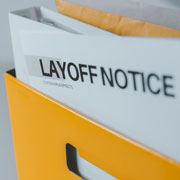Consider WARN Act Legalities If You Need to Lay Off Employees
Protection against the harshness of sudden job loss was the purpose of a law passed back in 1988. The Worker Adjustment and Retraining Notification (WARN) Act was adopted to help employees prepare to find new jobs — particularly if some training is needed to expand their employment opportunities — when their employer is forced to let workers go. Companies that fail to comply with that law could find themselves in a legal hot spot.
Indeed, one large labor law firm that represents employers recently alerted clients that the rest of this year “may become a hurricane season of sorts as WARN Act litigation could flood the courts.” What sparks litigation is a mass layoff that occurs without the required WARN Act notification delivered to impacted workers.
Who Is Affected?
While the most vulnerable employers are large ones with at least 100 full-time employees, even companies that aren’t subject to the law should be acquainted with its requirements; they might be subject to it in the future. (Note: state and local laws may have lower thresholds; for example, Wisconsin, Tennessee, New York use a 50-employee threshold)
In addition, it’s generally a good idea to be as transparent as possible with employees about your plans. Employees who can reasonably be expected to be laid off will appreciate any extra time they can get to prepare for that event. And employees not impacted may be comforted by the knowledge that they aren’t in jeopardy of losing their jobs, at least not in the near future.
When notifications are required, they go to impacted employees and to local “rapid response” offices within state employment offices that collaborate with the U.S. Department of Labor’s Employment Training Administration to assist laid-off workers. Such offices might also offer support for laid-off workers even if their employers aren’t subject to the WARN Act.
Additional criteria (besides employer size) dictate when the WARN Act is applicable. Employees covered by the law, including not only hourly but salaried, managerial and supervisory workers), are those who:
- Are terminated or laid off for more than six months or have their hours reduced 50% or more in any six-month period as a result of a plant closing or mass layoff,
- May be “reasonably expected” to experience a job loss, and
- Are part-time employees.
While the number of part-timers on your payroll doesn’t determine whether you fall under the WARN Act’s jurisdiction, part-timers who will or are expected to be laid off must also be notified.
According to the Department of Labor (DOL), workers not entitled to WARN Act warnings include those on strike or locked out in a labor dispute, workers “on temporary projects or facilities of the business who clearly understand the temporary nature of the work when hired,” and “contract employees assigned to the business but who have a separate employment relationship with another employer and are paid by that other employer.”
Triggering Events
As noted, a planned or anticipated layoff needs to be substantial to trigger WARN Act obligations. Layoff scope triggers include:
- The closure of a facility or operating unit affecting at least 50 full-time employees,
- A layoff over a 30-day period involving 50 to 499 employees who constitute at least one-third of the workforce (excluding part-timers),
- A layoff of 500 or more workers at a single employment site, regardless of the proportion they represent of the entire workforce, and
- A layoff that cuts at least 50 employee work hours by at least 50% each month over a six-month period.
The WARN Act includes three important exceptions to notification requirements. One is a natural disaster that forces a halt in operations. A second one applies to companies that are “faltering,” are “actively seeking capital in good faith” and believe that giving a heads-up of an impending mass layoff would preclude their ability to secure financing.
The third exception has come into sharp focus during the COVID-19 pandemic but may be slipping away. It’s when you need to conduct a mass layoff due to “unforeseeable business circumstances” that are “sudden, dramatic, unexpected and outside of the employer’s control.”
The COVID-19 Factor
The forced shutdown of businesses in many parts of the nation during the early phase of the pandemic would come under this heading. Its applicability today, however, around eight months after COVID-19-induced shutdowns began, is less clear. The DOL has issued a set of questions and answers about the applicability of the WARN Act today,
Here’s one revealing inquiry: “For permanent layoffs, may I claim an exception to the WARN Act because of COVID-19?”
The DOL’s answer was a recommendation that employers give a careful reading of its regulations that describe “unforeseeable business circumstances.” One key sentence is as follows: “The test for determining when business circumstances are not reasonably foreseeable focuses on an employer’s business judgment.”
If challenged, that assessment ultimately will be made by a federal judge, as “the WARN Act is enforced by private legal action,” the DOL explains, not the agency whose job is limited to “providing guidance and information” about the WARN Act.
The law firm predicting a spike in litigation offers the following warning: “With every passing day, the viability of the unforeseen business circumstances exception becomes weaker.” This could apply to you if you laid off employees expecting to bring them back within six months and therefore didn’t give them the WARN Act warning. Now with the six-month mark rapidly approaching, if you can foresee that you won’t be bringing your workers back soon, you may need to take quick action to minimize your exposure to litigation.
If this describes your situation, carefully consider what the future holds. Contact your legal advisor to ensure your bases are appropriately covered.

